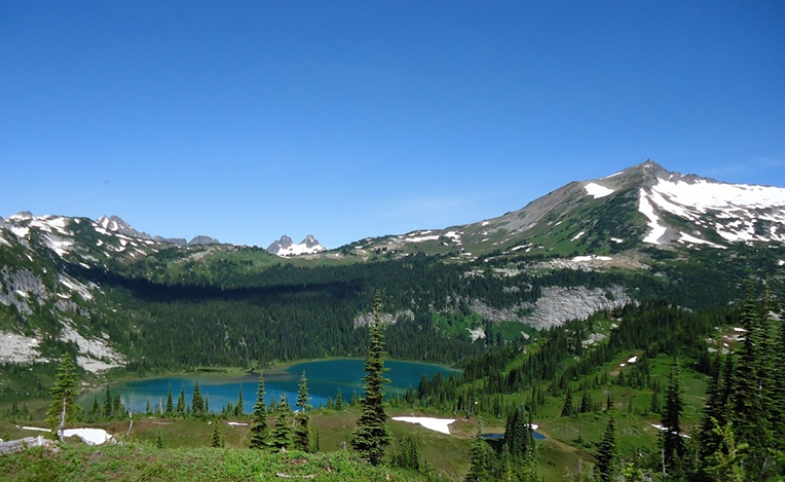The CPD Blog is intended to stimulate dialog among scholars and practitioners from around the world in the public diplomacy sphere. The opinions represented here are the authors' own and do not necessarily reflect CPD's views. For blogger guidelines, click here.

Cascadia’s News Media Deploy Ecological Public Diplomacy
The massive slowdown of global travel brought on by the COVID-19 pandemic has highlighted the growing importance of cross-border capital and cultural flows to international border zones globally and within North America. Simply put, the flow of economic, political and media activity across these regions and their borders reflects a much larger story about where the hyperlocal fits in with the global. A good example of this lies in the area where the U.S. Pacific Northwest meets Western Canada. I’m referring to the cross-border region known as Cascadia.
This is a region that includes much of British Columbia, Washington State and Oregon, though other conceptualizations show Cascadia fanning out to also include parts of Alaska, Idaho, Alberta and the Yukon Territory. While this concept is typically understood through interpretations of regional geography, it has gained increasing traction over the decades through social and cultural interpretations. That is to say, there is more to Cascadia than shared mountain ranges, cross-border watersheds and marine ecosystems such as the Salish Sea, though geography is a big part of the story. To map out the essence of Cascadia and regions like it is to also identify shared culture and values.
Regardless of one’s cartographic inclinations, Cascadia presents a compelling case study in how cross-border cultural flows serve as a form of public diplomacy. That’s because news media and popular culture shape our understanding of political, cultural and ecological space. The ties that bind this region are enhanced not only through formal institutions and longstanding cultural linkages. They are cemented by concurrent visions of how humankind might interface with ecology, urbanity and industrial/commercial activity in the future. Media entities, including broadcasters and news services, play a big role here. So, too, do public communication initiatives on the part of companies, governments and NGOs.
Cascadia presents a compelling case study in how cross-border cultural flows serve as a form of public diplomacy.
Specific cross-border initiatives such as the Cascadia Innovation Corridor, launched in 2017, remind this region’s citizens and leaders that pro-active international collaboration in commerce, transportation and the environment can lead to mutually beneficial outcomes for both countries in the Cascadia partnership. At the same time, inter-regional (and international) differences or tensions related to policy highlight the complexity of the region and the importance of civic media specifically in telling Cascadia’s story. A good example of this is the Seattle Times’ ongoing and award-winning Hostile Waters series, which has provided a comprehensive investigation of the plight of the endangered Salish Sea orcas to audiences in the U.S., Canada and internationally. The health of these killer whales is interconnected to numerous ecological and economic variables, including salmon populations, the health of rivers including the cross-border Columbia, Fraser and Skagit watersheds, and impacts of fishing, forestry and mining sectors.
This interplay of news media, eco-regionalism and international jurisdictions is a critical means to engaging publics and policymakers in multiple jurisdictions. It’s the focus of my recent research about Cascadia’s media systems sponsored by the Border Policy Research Institute at Western Washington University. Cascadia’s dynamic media ecosystem points to shared aspirations for economic prosperity and ecological sustainability.
The latter environmental theme—which situates Cascadia as an international biozone—is perhaps the most important catalyst for short- and long-term media activity and readership interest. The reporters and media institutions interviewed for my study repeatedly noted that, unlike political, economic and cultural institutions, the natural world does not recognize national borders—at least not to the same extent. And like the Seattle Times’ orcas series, these are stories that also play to media audiences nationally and globally as the region serves as a microcosm for planetary ecological challenges.
Furthermore, Cascadia’s global reputation is increasingly linked to its legacy of environmental activism, its urban sustainability initiatives in cities like Seattle and Vancouver, and its drive to conserve precious wilderness areas. For example, the public debate surrounding the reintroduction of grizzly bears to Washington State’s North Cascades ecosystem has attracted interest across the American West and Canada, in great part because the debate symbolizes larger tensions playing out in contemporary society, including differences between urban and rural populations.
Another driver of Cascadia news coverage is business and technology. Innovation is reshaping the region’s major cities, and it is also reconfiguring relationships between jurisdictions on both sides of the U.S.-Canada border. This is evidenced by the expansion of Seattle-based companies like Amazon and Microsoft into British Columbia as well as the cross-border region’s dynamic real estate, high-tech industries and growing trade with the Asia-Pacific region.
But making this all viable in the long run is contingent upon strategic public diplomacy initiatives and a healthy media ecosystem. Long-term and seemingly far-fetched goals like a high-speed rail connecting Eugene, Oregon to Vancouver, BC necessitate not only staggering economic investment and engineering acumen, but also the ability to situate mediated public diplomacy as a foundation for the cross-border Cascadia relationship.
Visit CPD's Online Library
Explore CPD's vast online database featuring the latest books, articles, speeches and information on international organizations dedicated to public diplomacy.
POPULAR ARTICLES
-
November 3
-
November 5
-
November 13
-
November 25
-
December 17
Join the Conversation
Interested in contributing to the CPD Blog? We welcome your posts. Read our guidelines and find out how you can submit blogs and photo essays >.









